Linear TV vs CTV Advertising: Which One You Should Invest in 2025?
Developing an innovative and impactful marketing mix can be overwhelming, particularly when navigating the differences between Linear TV vs CTV Advertising.
You're here because you want to understand how to advertise your products or services effectively on television, learn the details of each medium, and make informed decisions that will promote your marketing game.
Perhaps you've dabbled in TV advertising before but found it challenging to determine whether Linear TV or CTV best fits your brand.
Or maybe you're searching for insights into current trends and strategies to help you stand out in a competitive market.
Whatever the case, you're in the right place.
You might wonder, "What are the key differences between Linear TV vs CTV Advertising, and how can I leverage them for my business?"
Here’s what you’ll find in this article:
📺 Understanding Linear TV vs CTV Advertising: I’ll define both mediums, and we will explore their unique characteristics, helping you grasp why each is important for modern advertising.
🛠️ Choosing the Right Strategy: You will learn how to evaluate your business needs and determine which advertising approach aligns best with your goals.
💡 Benefits of CTV Over Linear TV: We will discover CTV's advantages, including targeting capabilities and viewer engagement, and why it's becoming increasingly popular among advertisers.
💰 Budgeting for Your Campaign: You will gain insights into the cost differences of Linear TV vs CTV advertising and tips on finding affordable options that suit your budget.
📈 Measuring Success: Understand how to track the effectiveness of your campaigns through key performance indicators specific to each medium.
By the end of this article, you'll be equipped with the knowledge to make strategic advertising decisions, utilize the power of linear TV and CTV, and eventually drive better results for your business.
Stay with me as we dive into Linear TV vs CTV Advertising Strategies in 2024! 🌟
TL;DR
Navigating the landscape of Linear TV and CTV advertising is crucial for effective marketing.
Whether new to TV advertising or looking to refine your approach, having a clear understanding can significantly enhance your campaigns.
Here’s what you need to know:
- Understanding Advertising Mediums: Familiarize yourself with the characteristics of Linear TV and CTV to identify which aligns with your business objectives.
- Evaluating Your Strategy: Assess your needs and choose an advertising strategy that maximizes reach while staying within budget.
- Leveraging CTV’s Advantages: Explore how CTV's targeting capabilities can enhance viewer engagement compared to traditional Linear TV.
- Budgeting Wisely: Learn about cost considerations for both mediums and discover options that fit your financial plan.
- Measuring Campaign Success: Implement effective tracking methods to gauge the performance of your advertising efforts.
If you're ready to unlock the potential of your advertising strategy through a deeper understanding of Linear TV and CTV, let’s get started!
What Is TV Advertising?
Television advertising is a marketing tool that utilizes television's visual and auditory capabilities to reach a broad audience.
Understanding the Basics of TV Advertising
Commercials that combine sight, sound, and motion demonstrably increae brand awareness, recall, and affinity. Advertisers secure airtime during specific live events or time slots, allowing them to simultaneously showcase their products or services to millions of viewers.
The process begins with market research to identify target demographics, followed by producing effective ads to resonate with the audience.
The Importance of TV Advertising for Businesses
TV advertising remains vital to many marketing strategies due to its extensive reach and ability to create emotional connections with viewers. It allows brands to establish credibility and visibility in a crowded marketplace.
You can target specific demographics through strategic programming choices and improve your chances of converting viewers into customers. Despite the rise of digital marketing, television offers a unique platform for storytelling and brand engagement.
What Are the Different Types of TV Advertising?
Television advertising can be broadly categorized into two main types: Linear TV and Connected TV (CTV).
Linear TV Advertising
Linear TV refers to traditional television broadcasting, where commercials are aired during scheduled programming. Advertisers purchase airtime based on viewer ratings and demographics, delivering the same ad to a wide audience. This method is effective for brand awareness but lacks precision targeting in digital formats.
Connected TV (CTV) Advertising
CTV advertising, on the other hand, utilizes internet-connected devices to deliver ads. This approach allows for hyper-targeting, enabling advertisers to reach specific audience segments based on data such as viewing habits, interests, and demographics.
CTV combines the broad reach of traditional TV with the precision of digital marketing, offering measurable results and personalized messaging.
How Does Traditional Linear TV Advertising Work?
In Linear TV advertising, commercials are scheduled during specific programming slots on broadcast or cable networks. Advertisers purchase airtime based on factors like audience ratings and demographics, aiming to reach a broad viewer base.
The ads typically range from 15 to 60 seconds and are shown to all viewers watching the program, regardless of their preferences. This method is effective for building brand awareness but lacks the precision targeting capabilities of digital advertising.
How Does Connected TV (CTV) Advertising Work?
Connected TV advertising delivers video ads to viewers via internet-connected devices while they stream content. Advertisers can utilize first-party and third-party data to target specific audiences based on demographics, interests, and viewing habits.
CTV allows for more granular targeting than linear TV, enabling you to reach niche segments effectively. Ads can be served programmatically through an auction system, ensuring that the right message reaches the right audience at the right time.
Why Is CTV Gaining Popularity Among Advertisers?
Connected TV (CTV) is becoming increasingly appealing to advertisers due to several key advantages over traditional Linear TV.
What Are the Key Advantages of CTV Over Linear TV?
Here are some of the key advantages of CTV over Linear TV:
- Precise Targeting: CTV allows for highly specific audience targeting using first-party and third-party data. Advertisers can reach viewers based on demographics, behaviors, interests, and even past interactions with the brand, which is more refined than the broad targeting available in Linear TV.
- Higher Engagement Rates: CTV ads typically have higher completion rates because viewers are more engaged with the content. This leads to better brand recall and effectiveness than traditional ads that may be skipped or ignored.
- Real-Time Analytics: With CTV, advertisers can access detailed performance metrics and analytics, enabling them to measure the effectiveness of their campaigns in real time. This data-driven approach allows for quick adjustments to optimize ad performance.
- Cost-Effectiveness: Targeting audiences by segment helps reduce wasted ad spend, making CTV a more cost-effective option for many advertisers. This is particularly beneficial for local businesses looking to reach specific geographic areas.
- Cross-Device Capabilities: CTV advertising can integrate with other digital marketing efforts, allowing brands to track user interactions across devices and platforms.
How Does Viewer Behavior Influence CTV Adoption?
A radical shift in viewer behavior has contributed to the rise of CTV advertising. As more consumers move away from traditional cable subscriptions in favor of streaming services, advertisers are adapting their strategies to follow this trend.
Viewers now prefer on-demand content that allows them to choose what they watch and when creating an environment where targeted advertising can thrive. Additionally, the increasing use of smart TVs and OTT devices means audiences are more accessible through digital channels.
Advertisers recognize that engaging with viewers in this manner not only aligns with their viewing habits but also enhances the effectiveness of their marketing efforts by delivering relevant content directly to interested consumers.
How Much Should Businesses Expect to Spend on TV Advertising?
When considering a budget for TV advertising, businesses must understand the cost structures associated with Linear TV and Connected TV (CTV).
What Are the Cost Differences Between Linear and CTV Advertising?
Linear TV advertising typically involves higher costs due to the need for direct negotiations with network broadcasters. Prices vary widely based on the time slot and the program's popularity.
For example, prime-time slots can command CPM (cost per thousand impressions) rates ranging from $20 to $40, especially on premium networks.
In contrast, CTV advertising is generally more cost-effective. Depending on the platform and audience targeting, costs can range from $10 to $30 CPM.
CTV allows for programmatic buying, which means advertisers can purchase ad space in real-time. This allows them to optimize their budgets more effectively and reduce the waste associated with broad audience targeting typical of linear TV.
Are There Affordable Options for Small Businesses?
Small businesses looking to enter the TV advertising space will find that CTV offers more flexible and affordable options than traditional Linear TV.
Many CTV platforms do not require minimum spend commitments or bundled packages, making it easier for smaller advertisers to test campaigns without a hefty upfront investment.
Vibe is a TV advertising platform that provides an accessible solution for small businesses aiming to leverage the power of TV advertising without breaking the bank.
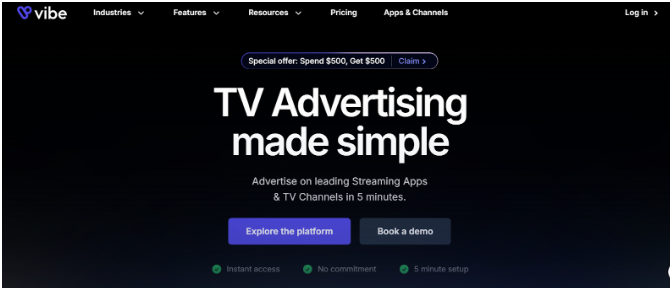
Vibe offers an affordable TV advertising solution with competitive CPM rates ranging from $15 to $35, making it accessible for all budgets. You can achieve between 143,000 and 333,000 impressions while utilizing various targeting options, including interest, demographic, and geographic criteria.
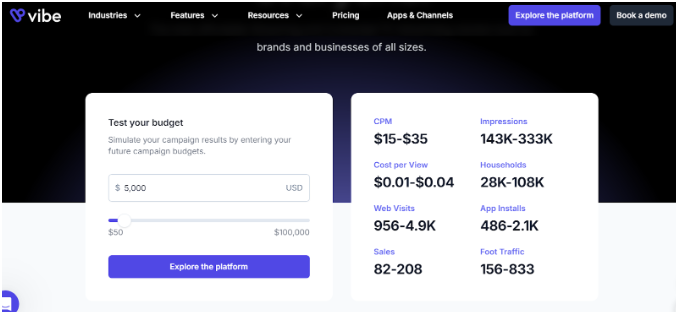
Its cost per view is just $0.01 to $0.04, and businesses can drive web visits and app installs at a low price. Additionally, Vibe allows advertisers to start campaigns with initial investments beginning at $500.
This affordability allows businesses of all sizes to engage their audiences effectively while maximizing their marketing budgets.
How Can Businesses Measure the Success of Their TV Campaigns?
Measuring the success of TV advertising campaigns is crucial for understanding their effectiveness and optimizing future strategies. Businesses can assess performance through various Key Performance Indicators (KPIs) that align with their campaign objectives.
Common metrics include reach, conversion rates, engagement levels, and return on investment (ROI). Marketers can gain insights into viewer behavior, ad impact, and overall campaign effectiveness by analyzing these KPIs.
What Key Performance Indicators Should Be Considered?
- Reach: This metric indicates the number of unique viewers who have seen the ad at least once, providing insight into the campaign's visibility.
- Frequency: Measures how often the same viewer sees the ad, helping to assess potential viewer fatigue or saturation.
- Conversion Rate: This tracks the percentage of viewers who take a desired action after seeing the ad, such as purchasing or visiting a website.
- Engagement: Metrics like viewability and interaction rates reflect how well the ad captures the audience's attention and encourages action.
- Return on Investment (ROI): Calculates the financial return relative to the campaign costs, helping businesses evaluate overall effectiveness.
How Do Measurement Tools Differ Between Linear and CTV?
Linear and Connected TV measurement tools (CTV) vary, primarily due to their inherent differences in audience engagement and data collection capabilities.
- Linear TV relies on traditional metrics from rating agencies like Nielsen, focusing on broad demographic data and general viewership statistics. These tools often lack granularity in tracking individual viewer behavior.
- Conversely, CTV utilizes advanced digital analytics that allows for real-time tracking of viewer interactions and detailed performance metrics. CTV platforms can measure specific actions taken by viewers, such as clicks or conversions, providing more precise insights into campaign effectiveness.
What Makes a Successful TV Advertisement?
A successful TV advertisement captures attention, conveys a clear message, and resonates emotionally with viewers. Its key elements include creativity, strategic placement, and audience targeting.
By combining these factors, advertisers can create memorable campaigns that promote their products and foster a connection with the audience.
How Important Is Creative Content in TV Ads?
Creative content is crucial in advertising, distinguishing a brand from its competitors. Innovative visuals, engaging narratives, and unique concepts can significantly enhance viewer engagement and retention.
Creative ads are more likely to leave a lasting impression, making it easier for consumers to recall the brand later. Creativity infused with emotional appeal or humor further strengthens the connection between the ad and the audience, increasing the likelihood of consumer action.
What Role Does Storytelling Play in Effective Advertising?
Storytelling is vital in effective advertising. It creates an emotional narrative that resonates with viewers. A well-crafted story can evoke feelings such as joy, nostalgia, or empathy, making the advertisement more relatable.
This emotional connection captures attention and encourages viewers to engage with the brand on a deeper level. By guiding audiences through a narrative journey, advertisers can effectively communicate their brand values and messages, leading to increased brand loyalty and recognition.
What Should You Look for in a TV Advertising Agency?
When selecting a TV advertising agency, consider the following key factors:
- Ease of Use: Look for platforms with a user-friendly interface that allows you to set up campaigns quickly. For instance, Vibe enables advertisers to launch campaigns in as little as five minutes, making it accessible even for those with limited experience in TV advertising.
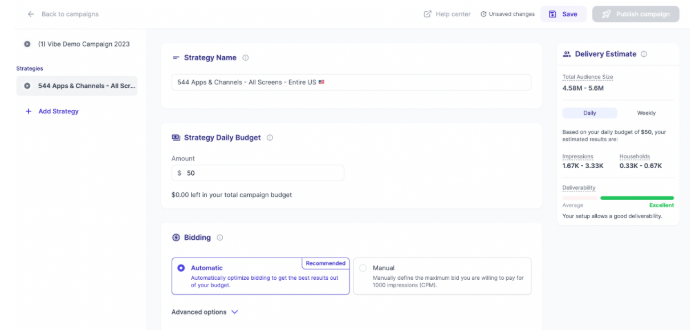
- Targeting Capabilities: Choose an agency that allows precise audience targeting based on socio-demographic characteristics and interests. Vibe provides options to reach specific demographics, ensuring your ads are shown to the right viewers.
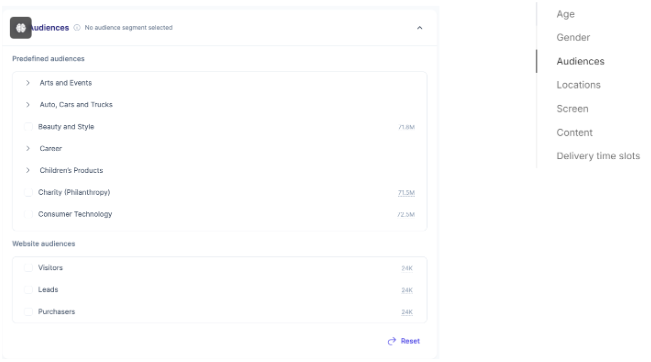
- Channel Variety: Ensure the agency can access various channels and streaming apps. Vibe offers over 500 options, including local news and sports channels, which can enhance your campaign's reach.
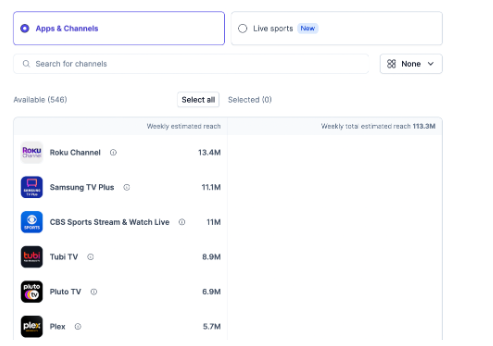
- Performance Tracking: Select an agency that provides real-time analytics and performance measurement tools. Vibe allows users to track campaign performance directly on their platform or integrate with third-party analytics tools.
- Cost-Effectiveness: Investigate pricing structures and minimum spend requirements. Vibe's platform is designed to be budget-friendly, with minimum spending starting at just $50 per day.
- Review Performance Measurement Tools: Vibe’s platform includes real-time reporting features, enabling advertisers to monitor their campaigns closely.
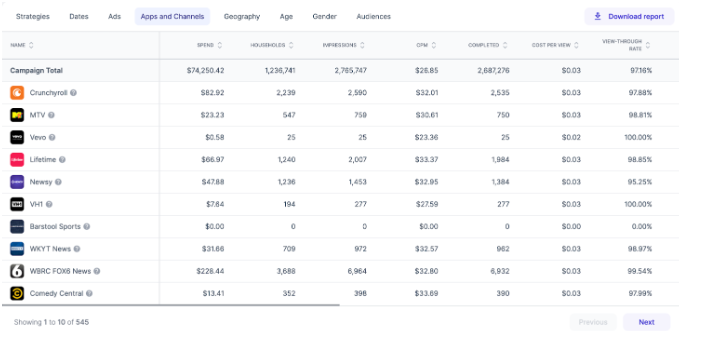
Why Is Vibe a Leading Solution in the Market?
Vibe distinguishes itself as a leading solution in TV advertising for several reasons:
- Accessibility for Small Businesses: Vibe operates like "Facebook ads for TV," making it easier for small businesses to enter the TV advertising space without extensive resources or expertise.
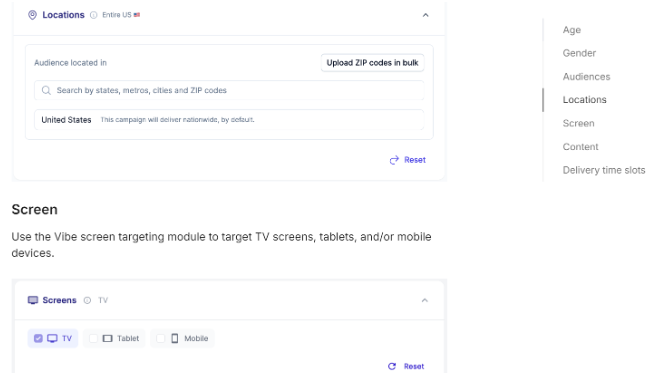
- Performance Metrics: Users report impressive returns on ad spend (ROAS), with some achieving over 1000% ROAS using Vibe's platform. This demonstrates its effectiveness in driving sales and brand awareness.
- Comprehensive Support: The platform offers robust customer support, ensuring advertisers receive assistance throughout their campaign journey. Many users have praised the responsiveness of Vibe's support team.
- Innovative Features: Vibe continuously updates its offerings, including the ability to target specific local markets and access premium inventory at competitive CPMs. This adaptability keeps it ahead of competitors in the rapidly evolving advertising landscape.
Should Your Business Invest in TV Advertising?
Investing in TV advertising can be a strategic move for many businesses. It offers the potential to reach a large audience quickly and effectively, enhancing brand visibility and credibility. TV advertising benefits businesses that establish a strong market presence and engage with consumers through compelling storytelling and visuals.
How to Evaluate Your Business's Advertising Needs?
To evaluate your advertising needs, consider the following steps:
- Identify Your Goals: Determine what you aim to achieve with your advertising, such as brand awareness, lead generation, or sales growth.
- Understand Your Audience: Analyze your target demographic to ensure that TV advertising aligns with where they consume media.
- Budget Considerations: Assess your advertising budget and compare it against potential returns on investment from different channels, including TV.
What Factors Should Influence Your Decision-Making Process?
Several factors should influence your decision-making process regarding TV advertising:
- Audience Reach: Consider the size of the audience you want to reach and whether TV can effectively deliver that audience within your budget.
- Engagement Level: Evaluate how effectively TV advertising can engage viewers compared to other mediums, especially regarding emotional impact and brand storytelling.
- Cost vs. Benefit: Weigh production and airtime costs against the potential benefits, such as increased brand recognition and sales performance.
- Integration with Other Channels: Consider how TV advertising can complement your marketing strategies, particularly digital channels, which may enhance overall campaign effectiveness.
Conclusion
Understanding the strengths of linear TV vs. CTV advertising can help you make the best decision for your business.
Both methods have unique benefits, but knowing how they fit into your marketing strategy is key.
Let’s quickly recap what we’ve discussed:
| Aspect | Linear TV | Connected TV (CTV) |
|---|---|---|
| Definition | Traditional television broadcasting with scheduled programs. | Internet-connected Streaming TV devices deliver ads |
| Audience Targeting | Broad targeting | Hyper-targeting |
| Ad Delivery | Ads are aired at specific times during scheduled programming. | Ads are delivered programmatically to specific viewers in real-time. |
| Viewer Engagement | Lower engagement as ads are more likely to be irrelevant or ignored. | Higher engagement rates due to more relevant and targeted content. |
| Cost Structure | Higher CPM rates | More cost-effective CPM rates |
| Analytics | Limited | Real-time, data-driven analytics |
| Suitability | It is ideal for brand awareness campaigns targeting large audiences. | Better suited for performance-driven campaigns with targeted, measurable outcomes. |
| Cross-Device Integration | Not available | Tracks user interactions across multiple platforms. |
You can choose the advertising method that best aligns with your goals and budget by weighing these factors.
Vibe’s ability to target specific viewers and track performance in real time can help you connect with your audience like never before.
So why not take the plunge?
Explore Vibe’s TV advertising today and see how it can elevate your marketing game!



